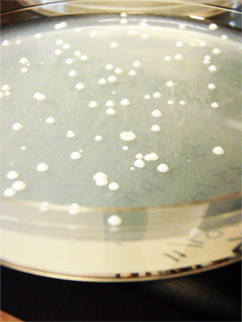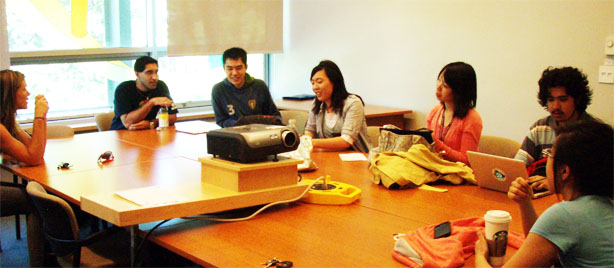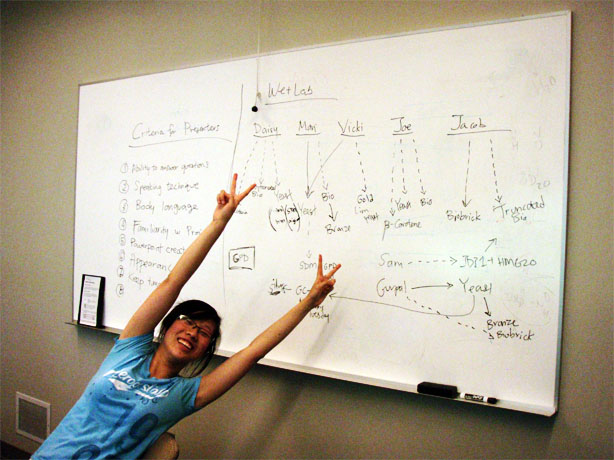Team:British Columbia/Notebook/Week 8
From 2011.igem.org

 |
 |
 |
 |
 |
Contents |
July 24 2011
(-)-limonene
- Results from transformation:
- Positive control: TMTC
- Negative control: no colonies
- pADM743: TMTC
- Set up O/N culture for mini-prepping
- 4 tubes: 3 colonies picked + 1 control
Track: Beta-pinene synthase
Marianne gel verified her cPCR using both G1004/G1005 and VF2/VR primers, but they showed no bands.
July 25 2011
On July 25th, Gurpal performed a yeast transformation. He transformed his purified pBS and pKS into 2 separate wildtype yeasts. He followed a protocol, left the cells to incubate at 30 degrees Celsius at 3:10pm, heat shocked them for 20 minutes at 42 degrees Celsius and then plated them at 5:30pm. The plates were marked with URA so that the plasmids could grow on them. Then, they were incubated in a 30 degree Celsius incubator.
(-)-limonene
- Miniprepped pADM743
beta-pinene
- Transformation (yeast plasmids + synthase) show a few colonies each on 3 plates (original-his-GAL, SDM-no-his-GPD, SDM-no-his-GAL)
- cPCR the yeast plasmid and synthase transformants
- Gel verification shows ligations successful!!
July 26 2011
beta-pinene
- Biobrick assembly
- Restriction digested and ligated synthase and psb1C3
- Set up ON culture for yeast plasmids
Marianne and Jacob are putting their parts in the biobricks plasmids!
Alpha- Pinene
July 27 2011
On July 27th, Alina observed the cells and noted that the transformation was a success.
beta-pinene
- Transformed ligations
- Miniprepped yeast plasmids
- Yeast transformation of SND and SDL into wildtype yeast, pKS yeast, pBS yeast
1,8-cineole
- The previous colonies of E. coli that should have had the 1,8-cineole gene on pSB1C3 were shown to have different sized plasmids after overnight cultures and minipreps. Of the 5 colonies, 4 had plasmids a little over 2 kb in size, and one had a plasmid around 5 kb in size. The 1,8-cineole gene is 1.7 kb and the pSB1C3 plasmid that is left after the restriction digest is 2 kb, so the product should have been around 3.7 kb. A restriction digest with ECORI and PSTI showed only one band for the 5 kb product, and the 2 kb product showed bands at about 1.7 kb and 700 bp. All of these were grown on chlor plates and chlor LB broth for the overnight culture. A gel of just the pSB1C3 showed a product well below the 500 bp mark on 1 kb ladder.
- This was rather disconcerting, so Jacob decided to run another biobrick PCR and try the ligation again.
July 28 2011
beta-pinene
- Biobrick ligations
July 29 2011
beta-pinene
- Biobrick transformation
July 30 2011
Track: Alpha-pinene synthase
Joe finally received his primers for PCR amplification of his SDM-alpha pinene synthase necessary for the ligation into yeast and biobrick plasmids. He did a PCR using these primers. However, no PCR products were seen after gel verification. The annealing temperature may have been too low at 55 degrees Celsius. Therefore, he needs to increase the annealing temperature to 60-72 degrees Celsius, the optimal temperature for Phusion Hot Start Polymerase.
 "
"




















